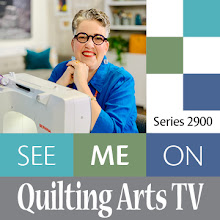 |
| Trouble cat says, “Take me with you!” |
If you’ve been checking in on my blog every few days, you may have noticed that it’s been mighty quiet around here lately. That’s mostly because I’ve been on the road a lot this month. In the past two weeks, I’ve taught four days and given two lectures, and traveled to nearby Concord, NC, to the Cabarrus Quilters Guild and to the Lake Quilters Guild of Smith Mountain Lake, near Roanoke, VA.
I love speaking and teaching, but I also need time in my studio to work and think and create. Today I got a little. I am starting to work on a commission piece, and this time, I am experimenting with tweaking my preparation process.
When basing a piece on one of my photos, I often start by tracing an 8x10" printout. I add things, take things out, or move things around while I trace. Then I scan in this traced drawing, enlarge it and print it out in “tiles” (or sections), and use this printout as my pattern. If the piece will be done using fused applique, it becomes the pattern for the fabric pieces. If the piece will be wholecloth painted, I place it under fabric and trace the lines.
This time, instead of using an 8x10" photo, I had my photo enlarged to a 2 x36" poster through PosterBrain. It cost me $19 plus shipping, arrived very quickly, and the quality was fantastic, just like a giant photographic print. Here it is, spread out on my cutting table:
A student at one of my workshops suggested a type of tracing paper I’d never heard of before called Bumwad. Sounds like toilet paper, right? ;-) It is actually a type of tracing paper used by architects, and it comes in big, wide rolls, up to 24" and 36" wide. Bumwad is available through ArtSuppliesOnline. I paid $16.23 (plus shipping) for a 24" x 50 yard roll.
I placed a piece of Bumwad (fighting the giggles now, each time I write that) on top of the photo and taped it down.
Then I started tracing the main lines in the photo. (You can see the photo I printed out on my laser printer next to the pen.) My first impression is that the Bumwad is a tad heavier than traditional tracing paper, which has its pros and cons for my process. It does not tear as easily (pro), but it is also harder to see through (con). I could put it on top of a light box, but because the poster is on paper that is nice and heavy, I doubt that the light box would help me see any better. I do find that I am able to see better when I flip on the lower setting of my overhead desk light, rather than the brightest setting.
I am reserving judgment on whether I like these materials or the changes to my process, but I’ll let you know as I work more on this project. I am thinking about using some melted Tyvek pieces on the bumpiest of the pumpkins in this piece.
















I enjoy seeing your process as you make a new piece.
ReplyDeleteDebbie
I'm still giggling over the name! Its good marketing though....we won't forget "Bumwad"! I'd love to have tracing paper so wide! And the Poster Brain quality is wonderful! Thanks for sharing!
ReplyDeleteHi Susan,
ReplyDeleteThanks for sharing this new process to your work. It's always fun to play with new tools and materials.
Melted tyvek sounds awesome! It'll definitely give the right texture of a bumpy squash.
Cheers,
Leah
I love your process. I have made a couple of small wall quilts based on photos. But my process is a little different because I do mine using needle turn applique. I continue to be in awe of your talent and learn something new everytime I stop by. Hugs
ReplyDeleteTrouble looks like he/she can live up to his/her name! lol
ReplyDeleteThat poster size print has fantastic quality, and is much cheaper than you can get it from the office supply stores' copy centers. They charge about $50 for one that size. That's a great deal!
I love the name Bumwad. lol Having paper that wide would be so good, though. I'd be anxious to see the melted tyvek technique!
Oh, bumwad! I still have a couple of rolls of bumwad from my architecture school days a few (ahem) years ago!! I've used it for tracing purposes now and then, but didn't realize until now that many people aren't aware that bumwad exists! It comes in pale yellow as well as white. I wonder if the yellow would be easier to see through? I'll bring you some to try. My rolls aren't as wide as your roll, though.
ReplyDeleteBumwad, or trace, can be found at your local blueprint shop in most sizes and you won't have to pay for shipping. It is commonly found in white and also a soft golden color.
ReplyDeletefabulous! Love this technique.should try it with my photos.You're so talented!
ReplyDeleteSo glad to read your post. Glad you're back - I've missed you!
ReplyDeleteI'll be really interested to hear your thoughts and opinions about your new process as you work through it.
Love that word! sounds like something the British would make up, lol.
ReplyDeleteGreat seeing these process pics. Interested in how you like this bumwad in the end. Have you figured out why it got the name bumwad in the first place? (it is weird using it)
I love your ideas! Thanks for sharing. I've been using Tyvek for making long tubes for quilt storage. It's fun to work with.
ReplyDelete